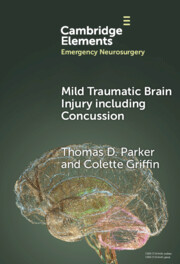Refine search
Actions for selected content:
187 results
Association between neuroticism and brain-wide structural outcomes: Mediation by vascular and mental conditions
-
- Journal:
- Psychological Medicine / Volume 55 / 2025
- Published online by Cambridge University Press:
- 14 November 2025, e343
-
- Article
-
- You have access
- Open access
- HTML
- Export citation
Brachial Plexopathy Due to Benzalkonium Chloride Poisoning: An Unprecedented Toxicity
-
- Journal:
- Canadian Journal of Neurological Sciences , First View
- Published online by Cambridge University Press:
- 12 September 2025, pp. 1-2
-
- Article
- Export citation
Comparison of cone beam and multidetector scanner irradiation for ear imaging
-
- Journal:
- The Journal of Laryngology & Otology / Volume 139 / Issue 12 / December 2025
- Published online by Cambridge University Press:
- 05 September 2025, pp. 1177-1180
- Print publication:
- December 2025
-
- Article
- Export citation
Commentary on the paper by Madira et al
-
- Journal:
- Cardiology in the Young / Volume 35 / Issue 8 / August 2025
- Published online by Cambridge University Press:
- 26 August 2025, p. 1710
-
- Article
- Export citation
Factors affecting the correlation between high-resolution computed tomography and operative findings in cholesteatoma surgery – a systematic review
-
- Journal:
- The Journal of Laryngology & Otology , First View
- Published online by Cambridge University Press:
- 29 July 2025, pp. 1-10
-
- Article
- Export citation
14 - Our Sun
- from Part I - Stellar Properties
-
- Book:
- Fundamentals of Astrophysics
- Published online:
- 10 November 2025
- Print publication:
- 24 July 2025, pp 90-98
-
- Chapter
- Export citation
Chapter 6 - Neuroscience and Compassion
- from Part I - Compassion in Healthcare
-
- Book:
- Handbook of Compassion in Healthcare
- Published online:
- 27 June 2025
- Print publication:
- 17 July 2025, pp 52-59
-
- Chapter
-
- You have access
- Open access
- HTML
- Export citation
Do Physicians Intuitively Select Slow Progressors for Thrombectomy in the Extended Time Window?
-
- Journal:
- Canadian Journal of Neurological Sciences / Volume 52 / Issue 6 / November 2025
- Published online by Cambridge University Press:
- 12 March 2025, pp. 982-988
-
- Article
- Export citation
Chapter 18 - Wetware
- from Part IV - Neurobiological Theories
-
- Book:
- Looking Ahead
- Published online:
- 20 March 2025
- Print publication:
- 06 March 2025, pp 201-207
-
- Chapter
- Export citation
Chapter 14 - Future Applications of Flow Cytometry and Related Techniques
-
-
- Book:
- Multiparameter Flow Cytometry in the Diagnosis of Hematologic Malignancies
- Published online:
- 30 January 2025
- Print publication:
- 20 February 2025, pp 219-232
-
- Chapter
- Export citation
Tetralogy of Fallot with absent pulmonary valve and 22q11.2 deletion syndrome
-
- Journal:
- Cardiology in the Young / Volume 35 / Issue 3 / March 2025
- Published online by Cambridge University Press:
- 07 February 2025, pp. 604-605
-
- Article
- Export citation
1 - So Many Mirrors
- from Part I - Descent and Fall
-
- Book:
- Plotinus on the Contemplation of the Intelligible World
- Published online:
- 03 September 2024
- Print publication:
- 21 November 2024, pp 23-55
-
- Chapter
- Export citation
Utility of Novel Ultra-Low-Field Portable MRI in a Remote Setting in Canada
-
- Journal:
- Canadian Journal of Neurological Sciences / Volume 52 / Issue 4 / July 2025
- Published online by Cambridge University Press:
- 19 November 2024, pp. 632-638
-
- Article
-
- You have access
- Open access
- HTML
- Export citation
Chapter Three - Gross Anatomy and Imaging
-
- Book:
- Understanding Figures in Neuroscience Research
- Published online:
- 22 November 2024
- Print publication:
- 13 June 2024, pp 83-123
-
- Chapter
- Export citation
Rare case of total anomalous pulmonary venous return into the right atrium in situs solitus
-
- Journal:
- Cardiology in the Young / Volume 34 / Issue 4 / April 2024
- Published online by Cambridge University Press:
- 27 February 2024, pp. 919-921
-
- Article
- Export citation
Enlarged pituitary gland volume: a possible state rather than trait marker of psychotic disorders
-
- Journal:
- Psychological Medicine / Volume 54 / Issue 8 / June 2024
- Published online by Cambridge University Press:
- 15 February 2024, pp. 1835-1843
-
- Article
-
- You have access
- Open access
- HTML
- Export citation
Preliminary examination of the effects of an early parenting intervention on amygdala-orbitofrontal cortex resting-state functional connectivity among high-risk children: A randomized clinical trial
-
- Journal:
- Development and Psychopathology / Volume 37 / Issue 1 / February 2025
- Published online by Cambridge University Press:
- 22 January 2024, pp. 384-392
-
- Article
-
- You have access
- Open access
- HTML
- Export citation

Mild Traumatic Brain Injury including Concussion
-
- Published online:
- 14 December 2023
- Print publication:
- 18 January 2024
-
- Element
- Export citation
Frequency of cognitive “super-aging” in three Australian samples using different diagnostic criteria
-
- Journal:
- International Psychogeriatrics / Volume 36 / Issue 10 / October 2024
- Published online by Cambridge University Press:
- 24 November 2023, pp. 939-955
-
- Article
- Export citation
Ambulatory sedation for children under 6 years with CHD in MRI and CT
-
- Journal:
- Cardiology in the Young / Volume 34 / Issue 3 / March 2024
- Published online by Cambridge University Press:
- 11 September 2023, pp. 647-653
-
- Article
-
- You have access
- Open access
- HTML
- Export citation
